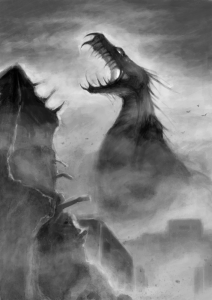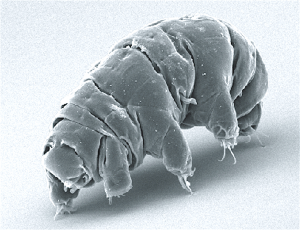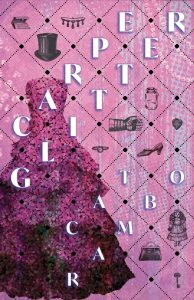An essay by Claire Gainsborough, as provided by Joachim Heijndermans
Art by Leigh Legler
You’ve seen it. Everyone’s seen it. Kids know of it from their school books. It’s been on TV, in movies, and in every history book published in the years after the incident of Singapore City. Hell, even if you’ve never seen the actual shot, you’ll know it from the ripoffs and the parodies and the references by college kids trying to be artsy in their projects. Cultural osmosis, I think they call it. It’s a hell of a thing, to have your work be absorbed by the current zeitgeist and spat back out, like a cheesy meme passed around on Twitter, to the point that everyone around the world will instantly recognize your photo on sight, even if they have never heard your name.
And I gotta say, with the passage of time, I don’t know how I even feel about the shot anymore. For one thing, it’s been nearly twenty years since I aimed that camera, pressed my index finger down, and made a piece of history in a split second of time. So yeah, that part’s cool. But you’ll be hard pressed to find anyone familiar with any of my other work. Last year I had a book collection of my travel photography published in conjunction with Nat Geo. Sales were so-so. Biggest complaint? That shot wasn’t in it. That’s all that people want anymore. Kagemura, on the most devastating day of my life.
Is this what Eisenstaed felt like when he shot that photo of the VJ day in New York? I doubt it, because even if that kiss was forced and all that, it still had some sense of beauty to it. A joy was captured in that scene. My shot? It’s beautiful in its own terrifying way. But I just see the carnage. Carnage in blood, rubble, and dust. Absolute carnage.

It stopped for a moment, as a thunderous rumble emitted from its throat (think a lion growl, but a billion of them at once), then tilted its head back to let out a deafening roar. And me? I took aim, clicked, and took the photo that defined that day and the rest of my life.
To read the rest of this story, check out the Mad Scientist Journal: Winter 2020 collection.
Claire Gainsborough, B.A., is a graduate of the School of Greater Design in Pasadena, CA. During her gap year, she survived the Day Zero event of the first Kagemura Ascendance in Singapore. After her trials, she became the most renowned photographer of our modern age, among the highlights being her works “The Titan Through the Dust,” “The Royal Wedding of the Prince and his Husband,” and the “Tezuka in Blue” series.
She currently lives in Colorado and can be contacted through her agent in New York.
Joachim Heijndermans writes, draws, and paints nearly every waking hour. Originally from the Netherlands, he’s been all over the world, boring people by spouting random trivia. His work has been featured in a number of publications, such as Ahoy Comics, Asymmetry Fiction, Gathering Storm Magazine, Hinnom Magazine, and The Gallery of Curiosities, and he’s currently in the midst of completing his first children’s book. You can check out his other work at www.joachimheijndermans.com, or follow him on Twitter: @jheijndermans.
Leigh’s professional title is “illustrator,” but that’s just a nice word for “monster-maker,” in this case. More information about them can be found at http://leighlegler.carbonmade.com/.
“The Titan Through the Dust” is © 2019 Joachim Heijndermans
Art accompanying story is © 2019 Leigh Legler


 Our alumni have been quite busy, so here’s a few more things they’ve been up to!
Our alumni have been quite busy, so here’s a few more things they’ve been up to!




